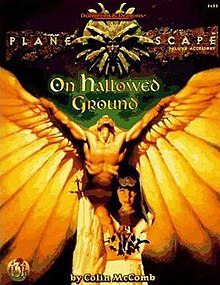
Planescape is a campaign setting for the Dungeons & Dragons fantasy role-playing game, designed by Zeb Cook, and published in 1994. It crosses numerous planes of existence, encompassing an entire cosmology called the Great Wheel, as developed previously in the 1987 Manual of the Planes by Jeff Grubb. This includes many of the other Dungeons & Dragons worlds, linking them via inter-dimensional magical portals.
In the fantasy role-playing game Dungeons & Dragons, an Outer Plane is one of a number of general types of planes of existence. They can also be referred to as godly planes, spiritual planes, or divine planes. The Outer Planes are home to beings such as deities and their servants such as demons, celestials and devils. Each Outer Plane is usually the physical manifestation of a particular moral and ethical alignment and the entities that dwell there often embody the traits related to that alignment.
Mystra is a fictional goddess in the Forgotten Realms campaign setting for the Dungeons & Dragons fantasy role-playing game.

The planes of the Dungeons & Dragons roleplaying game constitute the multiverse in which the game takes place. Each plane is a universe with its own rules with regard to gravity, geography, magic and morality. There have been various official cosmologies over the course of the different editions of the game; these cosmologies describe the structure of the standard Dungeons & Dragons multiverse.
The Factions are fictional philosophically based power groups in the Planescape campaign setting for the Dungeons & Dragons fantasy role-playing game.

Tiamat is a supremely strong and powerful 5-headed draconic goddess in the Dungeons & Dragons role-playing game. The name is taken from Tiamat, a goddess in ancient Mesopotamian mythology. She is the queen and mother of evil dragons and a member of the default pantheon of Dungeons & Dragons gods. Her symbol is a five-headed dragon.
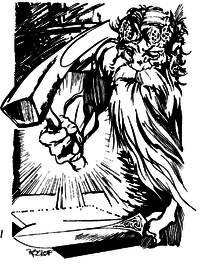
Moradin is the chief deity in the dwarven pantheon in the Dungeons & Dragons game and is a member of the default D&D pantheon. In 3rd edition, Moradin's domains are Creation, Earth, Good, Law, and Protection. The 5th Edition Players Handbook include Knowledge as a suggested domain. His titles include Soul Forger, Dwarffather, the All-Father, and the Creator. He created the first dwarves out of earthen materials and tutored them in dwarven ways.

Sigil is a fictional city and the center of the Planescape campaign setting for the Dungeons & Dragons fantasy role-playing game.
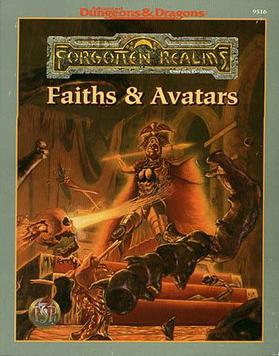
Faiths & Avatars is an Advanced Dungeons & Dragons Forgotten Realms campaign expansion book.

Dungeon Master Option: High-Level Campaigns is a supplemental sourcebook to the core rules of the 2nd edition Advanced Dungeons & Dragons (AD&D) fantasy role-playing game.

The Planescape Campaign Setting is a boxed set for the Dungeons & Dragons fantasy role-playing game. The set was designed by David "Zeb" Cook and published in 1994. It introduced the Planescape setting and was highly praised by White Wolf and Pyramid magazines.

The Nightmare Lands is an accessory for the 2nd edition of the Advanced Dungeons & Dragons fantasy role-playing game, published in 1995.

Planes of Conflict is an accessory for the second edition of the Advanced Dungeons & Dragons fantasy role-playing game, published in 1995.

Uncaged: Faces of Sigil is an accessory for the 2nd edition of the Advanced Dungeons & Dragons fantasy role-playing game, published in 1996.
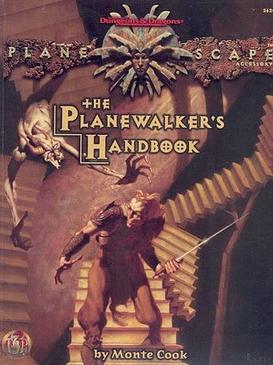
The Planewalker's Handbook is an accessory for the Planescape campaign setting in the 2nd edition of the Advanced Dungeons & Dragons fantasy role-playing game, published in 1996.

A Guide to the Astral Plane is an accessory for the 2nd edition of the Advanced Dungeons & Dragons fantasy tabletop role-playing game, published in 1996.
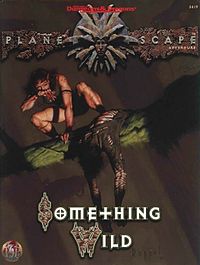
Something Wild is an adventure module for the 2nd edition of the Advanced Dungeons & Dragons fantasy role-playing game, published in 1996.

Hellbound: The Blood War is an accessory for the 2nd edition of the Advanced Dungeons & Dragons fantasy role-playing game.
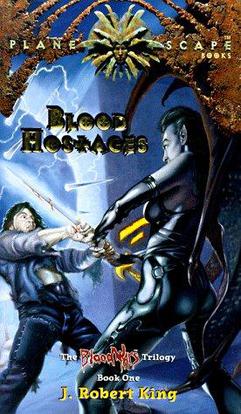
Blood Hostages is a fantasy novel by J. Robert King, set in the Planescape campaign setting, and based on the Dungeons & Dragons role-playing game. It is the first novel published in the "Blood Wars Trilogy". It was published in paperback, January 1996.

In the Dungeons & Dragons role-playing game, Corellon Larethian is the leader of the elven pantheon, and the deity of Magic, Music, Arts, Crafts, Poetry, and Warfare. Corellon is also considered a member of the default D&D pantheon. Corellon is the creator and preserver of the elven race, and governs those things held in the highest esteem among elves. Corellon's symbol was originally a crescent moon; in the 4th edition Corellon's symbol is a silver star on a blue field.
